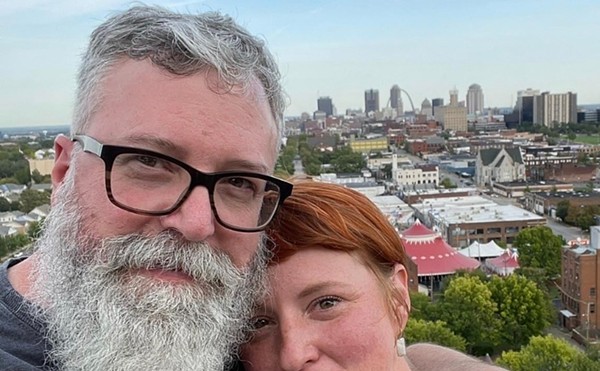At the very least, an exhibition like this promises to be entertaining. At the very best, it will be entertaining and intellectually stimulating, sparking a host of questions about our physical relationship to space and time. These questions seem especially timely, because we live in a world in which space, time and physicality itself seem increasingly threatened, almost to extinction, by their virtual counterparts. This is the wonder of Wonderland: There's nothing, or not much, virtual about it. It's about the physicality of experience and what happens physically and mentally when you move through and interact with another space.
The 10 installations here, as Wonderland curator Rochelle Steiner notes, were designed with the moving body in mind. So it was not surprising, on a recent visit to the exhibition, to hear visitors verbally express wonder, joy and, sometimes, confusion as they experienced the installations. Pipilotti Rist's "Ever Is Over All" is a video projection covering two walls, featuring a woman on a carefree slow-motion stroll through the streets of Zurich. A mother and her two children, viewing the work, were surprised that their cast shadows looked as if they were strolling alongside the woman in the video. "Do you see where you are?" the mother asked her kids. "There you are!" They were obviously having fun interacting with the work.
There's the danger, though, of thinking of Wonderland merely as some kind of high-art Disneyland. It's not. At Disneyland, visitors are taken to imaginary worlds that are reassuringly familiar. They don't lose their footing or their sense of spatial and social predictability. In Wonderland, the artists play at the edge of your physical and mental orientation, and that's what allows for the more grownup reflections on ourselves and how we relate to spaces. As soon as that young mother mentioned above saw how Rist's narrative unfolds -- the "carefree" woman in the video smilingly begins to smash car windows -- she ushered her children out of the gallery with haste.
Something of that edge is present in Olafur Eliasson's "The drop factory. A short story on your self-ref and rep," the first Wonderland work visitors are likely to see. It stands in the museum's central hall, a mirrored geodesic dome 20 feet high, with a door inviting entrance. The inside of the dome is covered in trapezoidal mirrors, reflecting the museum's Neptune fountain, which spurts water jets cut by a strobe light. It is a Wonderland of reflected and refracted light and water, and the trick is to locate yourself in any number of the mirrored panels that surround you. The initial effect is magical. But once that novelty has worn off, you begin to look at the installation's mechanism. The poor Neptune fountain is caught in a stranglehold of steel scaffolding, with ungainly, exposed water hoses snaking all about. In his interview with Steiner in Wonderland's catalog, Eliasson addresses this somewhat jarring explosion of the illusion. "I'm not a magician," he claimed. "Showing the machinery that creates the phenomenon makes it completely evident that my work is not natural, but artificial. It breaks the illusion."
Time and again, illusions are broken in Wonderland, and spatial and social expectations are subverted. Stephen Hendee's "Abandon.exe" is an enclosed, dimly lit space built of foam board and gaffer's tape. It seems vaguely like a futuristic cathedral, but the aisles and lateral passages in "Abandon.exe" lead nowhere. There's no architectural culmination, no payoff for following the paths, no grand altar or a rose window; instead, there are just more strange spaces, unfolding in no particular order with no particular logic. Spatial disorientation characterizes Jennifer Steinkamp's "X-Room," a space that looks to be straight out of some Kubrickian pop-space fantasy. With Bill Klaila's "Virtual Bog," the question of our presence in a fictional space becomes primary. The darkened gallery is filled with the sounds of bugs and water; on the floor, in a neat square, a digital projection simulates a watery bog. According to the exhibition guide, the movement of visitors on the pressure-sensitive floor produces the sloshy sound effects and images of ripples in the water. But it only appears to work some of the time, leading to some confusion about whether our presence actually matters in the space. More disorientation, more doubt.
But disorientation isn't all that happens here. Many of the works in Wonderland have the startling effect of heightening physical senses. Teresita Fernández's "Landscape (Projected)" consists of a room painted entirely green, an effect that dulls the visual senses but sharpens the sense of hearing (it gradually becomes quite obvious that the strange pulsating rhythm you hear is the sound of a rotating water sprinkler). Ernesto Neto's installation, involving pungent spices, sharpens the awareness of scents even after one has left the gallery. By the time visitors reach Janet Cardiff's "Taking Pictures," their senses have been piqued, which puts them in perfect position to appreciate the work. By way of the medium of a portable compact-disc player and a series of photographs, Cardiff accompanies visitors on a 15-minute walk that takes them out of the museum and into the woods just beyond it. The soundtrack is utterly convincing. Cardiff sounds as if she's speaking directly inside our heads. The recorded sounds of footsteps or an airplane passing overhead mesh perfectly with actual ambient sounds, until you can't distinguish between the two. Cardiff has managed to seamlessly merge her own experiences with ours. We walk where she walks; we touch what she touches; we even think what she thinks. Past and present time converge, and the memories she describes become palpably real to us. The effect is fascinating but also slightly unnerving. After all, Cardiff is controlling our experiences to a significant degree. Often her narrative wanders into Grimm's fairytale territory, where the woods often hold dark, scary secrets.
It makes a certain amount of sense, in that respect, to finish up the tour through Wonderland with a visit to "Pioneer Set" by Joep van Lieshout. We emerge from the forest to behold something that looks to have come straight out of another fairytale: a self-sufficient farm, with a farmhouse, chicken coops, rabbit hutches and the rest, designed with distinctively Dutch fastidiousness. A model for communal self-sufficient living, "Pioneer Set" projects a vision of an agrarian utopia in which people work in harmony with nature. It's sad to think that it makes more sense as an ideal than as a workable model for living.
That can, perhaps, be said about all of the installations in Wonderland. They are all ideals, in a way. They don't propose or dictate a way of behaving as much as they allow you to explore the possibilities of experience. Not all of the lessons we can learn from Wonderland are purely pleasurable; nor, to the exhibition's credit, are they meant to be. The exhibition as a whole requires a certain investment from the visitor, an investment of time, as well as physical and mental energy. If viewers are willing to do this, then Wonderland will deliver intellectual rewards that far surpass those of any exhibition in recent memory.





